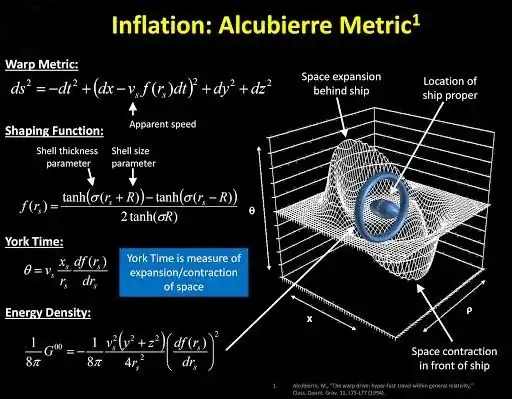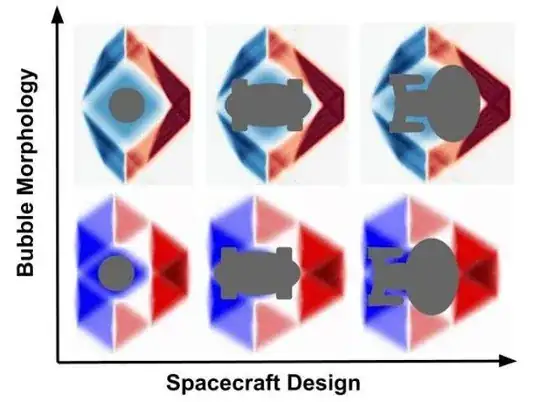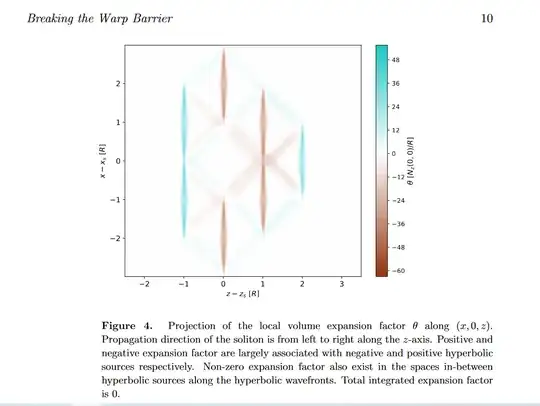Very good point, it goes to the heart of the debate around warp drive: what is the physical process that causes the warp drive bubble to move? And what would cause it to reach FTL speed? As I see it, there are two positions/hypotheses:
A): The original Alcubierre one, which says that the expansion/contraction of spacetime is the causal effect. The direction of travel is that space contracts in front of the bubble, expands behind it. In effect, the mechanism that causes the expansion of the Universe is "at work" locally and in a narrowly directed line. Just as the c-barrier does not apply to the expansion of the Universe, it does not apply to this. There is no detailed, computational model of how the bubble would reach FTL velocity. But this conception doesn't require it to be done by some kind of conventional spacecraft propulsion, but somehow it is done by expansion/contraction. (Alcubierre paper: https://arxiv.org/abs/gr-qc/0009013), (Alcubierre, Lobo paper https://arxiv.org/abs/2103.05610), (Lobo, Visser paper: https://arxiv.org/abs/gr-qc/0406083)
B) The other one that has become more common in recent years is that it is not the expansion/contraction of space-time that causes the warp drive to proceed, it is only incidentally related to it in some models. There are warp drive spacetimes with no expansion and contraction. According to this there is no realistic physical process behind it all, so the expansion of the universe is not a good analogy either. So warp drive is, for now, just a kind of paper-defined way of moving that fits with the rules of general relativity. Some unknown and as yet unimaginable drive would have to provide the FTL speed for the bubble. According to this, the position of a warp drive would in fact be the same as, not more realistic than the imaginary tachyons. (Bobrick,Martire paper: https://arxiv.org/abs/2102.06824)
As far as we know, neither hypothesis A) nor B) have been proven or disproven, but are competing alternatives. Important question raised here: if a new warp drive model is discovered, like Lentz, which version does it fit? Can we place it among those in which expansion and contraction can be detected and thus support that such a realistic effect can generate FTL motion? Or, on the contrary, is it rather a counter-example?
But the proponents of version B) not only claim to have developed a new hypothesis, they also claim that version A) is a fallacy which they have disproved and version B) has been proven. This is the sense of the Bobrick-Martire study and the main answer here, with which the questioner agreed, strongly states.
But it is not clear where this follows from, where would it be proven to be so? The Alcubierre-warp drive articles definitely attribute it to the effect of expansion/contraction, also for equivalent spacetimes (van den Broeck spacetime etc.) The main claim of Bobrick's answer here is, "warp drives move because they already move, or else they need to propel, and their movement is not related to spacetime expansion or contraction." I see he refers to the Natario article as having already demonstrated this.
But in the Natario warp drive there is also expansion and contraction, just not in front of and behind the bubble, but trickier. This is clarified on page 5 of the article by Natario: "This gives some insight into the geometry of this spacetime: for example for cos θ > 0 (i.e., in front of the bubble), Krr < 0 where f ′ > 0 (i.e., in the bubble's wall), indicating a compression in the radial direction; this is however exactly balanced by Kθθ + Kϕϕ = -Krr, corresponding to an expansion in the perpendicular direction".
Although the title of the article is indeed "WARP DRIVE WITH ZERO EXPANSION", and in the introduction the author also says that "this contraction/expansion is not necessary at all, and that in particular it is possible to construct a similar spacetime where no contraction/expansion occurs.". But as far as I can see, in his solution this does not mean that there is no expansion or contraction at all. It means that there is a different type than in the Alcubierre type and that, overall, contraction and expansion compensate each other. Thus, the essential
property of the warp drive is revealed to be the change in distances along the direction of motion, and not the
expansion/contraction of space volume. (Natario paper: https://arxiv.org/abs/gr-qc/0110086)
Thus, in my opinion, the paper is contradictory and does not prove that warp drive motion has nothing to do with the expansion/contraction of spacetime. Is there an example in the Bobrick-Martire study of a warp drive spacetime that has no expansion or contraction? Also, is there any proof more generally that version A) is incorrect?
Furthermore, suppose that they produce on paper a warp drive spacetime that really has no space contraction/expansion. This is an interesting theoretical development. But why would it prove that for warp drive models that do have expansion and contraction, it is not the cause of motion? The fact that we can theoretically design different models does not negate the properties of the original model.
The other main, related issue is acceleration and propulsion. B) says that this has nothing to do with the expansion/contraction of spacetime either, it would not cause the warp drive to progress. Rather it would require some kind of conventional and unknown propulsion that would accelerate the bubble to FTL speed.
It is not clear what evidence there is to support this. The Bobrick-Martire paper discusses the issue in chapter 5, and what I see there seems more opinion than proof. They categorizes as an error that Alcubierre originally introduced a time-dependent velocity into the metric, so his construction violates energy conservation. Am I right in thinking that Noether's theorem is behind this? That is, if we have a spacetime whose metric and hence Lagrange function is explicitly time dependent, then there is no energy conservation theorem for it. The best known example of this in standard cosmology is the spacetime describing the Universe, the Robertson-Walker metric. Yes, there is no binding energy conservation for the entire Universe - and that's not a problem. But I don't see why, in the case of the Alcubierre metric, a similar explicit time dependence would be a problem that should be corrected, that should be got rid of.


